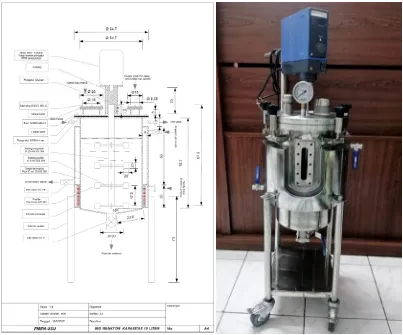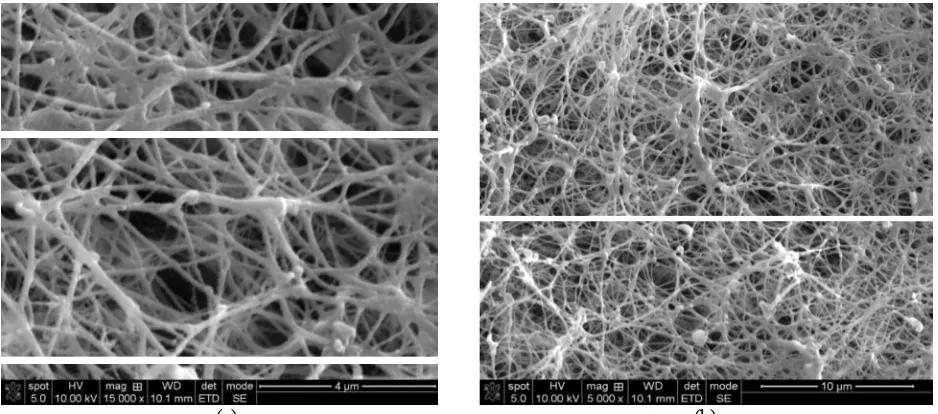Enhancing the quality of nata de coco starter by channeling the oxygen into the
bioreactor through agitation method
Saharman Gea, Khatarina Meldawati Pasaribu, Kerista Sebayang, Elisa Julianti, Suci Aisyah Amaturahim, Siti Utari Rahayu, and Yasir Arafat Hutapea
Citation: AIP Conference Proceedings 2049, 020064 (2018); doi: 10.1063/1.5082469
View online: https://doi.org/10.1063/1.5082469
View Table of Contents: http://aip.scitation.org/toc/apc/2049/1
Enhancing
The
Quality
of
Nata
De
Coco
Starter
By
Channeling
The
Oxygen
into
The
Bioreactor
through
Agitation
Method
Saharman
Gea
1,a),
Khatarina
Meldawati
Pasaribu
1,b),
Kerista
Sebayang
2,c),
Elisa
Julianti
3,d),
Suci
Aisyah
Amaturahim
1,e),
Siti
Utari
Rahayu
2,f),
Yasir
Arafat
Hutapea
1,g)1
DepartmentofChemistry,FacultyofMathematicsandNaturalScience,UniversityofSumateraUtara,Jl. BioteknologiNo.1,Medan20155
2
DepartmentofPhisycs,FacultyofMathematicsandNaturalScience,UniversityofSumateraUtara,Jl. BioteknologiNo.1,Medan20155
3
FoodScienceandBiotechnologyStudyProgram,FacultyofAgriculture,UniversityofSumateraUtara,Jl.Prof.A. SofyanNo.3,Medan20155
The provision of a proper quality starter to produce nata de coco through agitation method has been done. The main concern of this method was its effect after the oxygen flow into the bioreactor containing glucose-based medium which was inoculated byAcetobacterxylinum. The 10-liter bioreactor was operated with a stirring speed of 200 rpm at room temperature. After 10 days, the broth within the bioreactor was harvested and analyzed by using an optical microscope, and the results were compared with an oxygen-free broth. Based on the observation of bacterial clusters placed on the watch glass, the oxygenated broth was discovered to remain compact with each other. In contrast, the oxygen-free broth of the bacterial cluster was found to be cloistered. When the bacterial cluster was used to inoculate the media, the 15-day observation performed different results.
Keywords: Acetobacterxylinum, nata de coco, broth, agitation, and starter quality
INTRODUCTION
It is widely known that strains of bacteria are able to synthesise nanofibrils of cellulose on the surface of a medium containing the rich-food source like carbon, oxygen, hidrogen phosphate and nitrogen as macronutrients. Some of the bacteria that possess this ability areSarcina, Rhizobium, AgrobacteriumandAcetobacter[1]. However, it is only Rod-shaped gram negative bacteria strain such as Acetobacter xylinum are known able to produce large amounts of cellulose.
known in the vinegar industry. This type of bacteria can convert ethanol to acetic acid. microfibrils synthesized close to the cell surface of acetobacter xylinum will be tightly bound to form cellulose macromolecules. During culture, biological process of bacteria synthesis 12 to 70 molecules of cellulose and extruded the cellulose where they aggregate into micro fibrils from a cell into the growth medium through pores which are located about 10 nm separate in different arrangements on the cell surface [3]. The cellulose molecules bind each other via intermolecular hydrogen bonds between two successive rings after biogenesis near the surface of pure BC [4]. It can generally be named as an extracellular process because of the biogenesis process to synthesis of ultrafine microfibrils by Acetobacter xylinum occurs closed to the cell surface.
Based on its excellence mechanical properties, to form homogeneous membrane sheets under certain conditions and an ultra-finenetwork structure, BC is extremely useful for numerous applications [5-6]. BC fibres are also remarkable to be used asreinforcing agents in composites [7-8]. Therefore, the cultivation improvements approach of producing BC have been widely proposed to enhance BC production with the intention to improve the structure, increased the yield, and find effective methods to produced BC with better mechanical properties [9,10,5]. In several research, it was not only the production method that is modified, but also the growth medium, acidity of the medium, and carbon, oxygen, hidrogen phosphate and nitrogen source as macronutrients forAcetobacter xylinum
[11]. Moreover, researchers also innovate the method to conduct the characteristics of BC such as carrying out physical, thermal and morphological analyses.
Recently, there are three methods which is widely known to produce bacterial cellulose; shake culture, static culture,and rotating disk system. Every method has benefit and drawback. Static culture is a type of culture method for bacterial medium that is simple to do so it is widely used in previous research. However, because the growth of cellulose that produced by strain bacteria is relatively slow, the number of cellulose produced on the fermented broth surface is smaller than other methods [12]. This condition happens because in a static culture, bacterial cellulose which is formed on the surface of the culture blocks the incoming oxygen, thereby reducing the level of oxygen in the culture that needed by bacteria [13].
In the other hand, agitation culture is usually carried out in flask in a specially designed place such as a bioreactor. Based on existing research, it is known that compared to static culture, agitation culture is the most effective and efficient method for the production of large amounts of bacterial cellulose The work on the development of batch agitated culture process to produce bacterial cellulose fibre was firstly performed by Weyenhauser in the early 1980s collaborated with Cetus Corporation in California.
MATERIALS AND METHODS Materials
Acetobacter xylinum as a type of bacterial strain used in this study was obtained from the Microbiology Laboratory of the Agricultural Institute, Bogor, Indonesia. Ammonium sulphate, orthophosphate glucose, potassium hydrogen, magnesium sulphate and yeast extract is the chemicals that used for the culture medium. The chemicals used for the agar solid media were mannitol, bactopeptone and agar powder as a hardener. Sodium hydroxide, sodium hypochlorite and all the chemicals mentioned above are directly used in research after being received from VWR. To assist growth of the bacteria into the culture was added vitamin such as B1, B3 and B5 [6]. To avoid bacterial cellulose slipping when subjected to load when hotpressing a non-woven fabric and 200 meshsieve wire are needed. For the Gram-negative test of the bacteria, a series of common reagents such a
iodine, acetone, and safranin supplied by Aldrich were used.
Preservation of theAcetobacter Xylinum
FIGURE 1.The 10-liter bioreactor used for preservation process
RESULT AND DISCUSSION
Acetobacter xilynum culturing process
The strain of Acetobacter xylinumused was a stock supply from the Laboratory of Microbiology, Institute of Agriculture, Bogor. This strain was originally supplied by the National Institute of Science and Technology, Manila, calorie dessert in South East Asia [13]. There was no further treatment applied and it was used as received.
Acetobacterxylinum colonies can be sown gently on a solid gelatinous agar surface to get a new starter or broth, using an inoculating-hand loop and then transferred into medium B. This is done to replenish the bacteria and also to keep them viable and in good condition. Based on experience, the bacteria can be kept for 2 months in the agar solid in fridge. If the colour of the agar solid turns pale, it indicates that the viability of the bacteria has decreased and they must be refreshed with a new medium.
This is also a way of testing whether the Acetobacter xylinum has undergone mutation. Acetobacter xylinum
which has undergone mutation exhibits a rough colony and the bacteria dispersed from their aggregate (flocs), marking these bacteria as wild-type cells [14]. When these bacteria are obtained from the rough colony and inoculated into the liquid growth medium, they either fail to produce cellulose or produce non-cellulosic product. In this study, by adopting this method, it is possible to distinguish between the original Acetobacter xylinumand the wild ones because the bacteria which are not deficient mutants will be associated with each other.
BC pellicle [15]. It is important to pay attention to appropriate procedures to increase the production of bacterial cellulose when use of agitation culture.
FIGURE 2.Microphotographs of the colony of bacteria obtained from the surface area of solid agar media
The inoculation process produced a white layer on a surface of medium. This layer is called as pellicle (gel-like). It was found that the pellicle of BC obtained via agitation method is trunk shape and has an average depth of 1.3 cm and diameter of 12-15 mm (Fig. 3). It is indicated that applying the agitation method by also channeling the oxygen was enhancing the quality of the product formed. From the images taken, it can be seen that there are morphological differences that can be seen between bacterial cellulose produced through culture of agitation with bacterial cellulose produced through a static procedure. Cellulose produced by agitated culture would be fragmanted while static fermentation method in this research produce a thick pellicle of cellulose. [16]. Result also show, BC that produced by channeling the oxygen into the bioreactor through agitation method show resembles a unique form ellipsoidal BC shape. This was also supported by research conducted by Shoda and Sugano (2005) which showed that BC produced by chanelling oxygen in agitation culture produced BC pellets larger than BC pellets produced without chanelling oxygen [17].
FIGURE 3.The pellicle of BC via agitation method
The results showed that the amount of cellulose production produced did not depend on the rotational speed (rpm) used in the study using agitation culture but more dependent on the amount of oxygen flowed into the culture. This study reinforced by previous research which says that the amount of bacterial cellulose produced through agitation aeration culture is not significantly affected by mass transfer around the cell [20].
(a) (b)
FIGURE 4.The result morphological analysis of BC produced via agitation method method in (a) 15000X and (b) 5000X magnification
The morphological analysis result reveals that the pores of bacterial cellulose produced via agitation method is bigger compared to Bacterial Cellulose which was produced via static method. Agitation culture make the larger pores of bacterial cellulose because of the streching bands of cellulose caused the formation of cellulose microfibril woven distrupt [16]. The use of agitation cultures that are known can increase pores size of cellulose fibers makes agitation culture more effective for scaffolding applications than the use of static cultures that require functionalization before being used as scaffolding. This finding has a significant potential to innovate the BC as a scaffolding to grow cell such as ligament, cartilage, and others which are not containing blood vessel via in-vitro method.
CONCLUSION
In this research, it is discovered that producing the Bacterial Cellulose via agitation method shows a better result compared to the static method. Moreover, by channelling oxygen into the reactor during the production process, it can enhance the quality of the bacterial cellulose obtained.
ACKNOWLEDGEMENTS
Authors would like to send a gratitude to the Rector of University of Sumatera Utara for research funding via BPPTN 2016 scheme.
REFERENCES
1. M. H. Deinema and L. P. T. M. Zevenhuizen,Archiv fur Mikrobiolgie,78(1), 42-51(1971).
2. G. Joseph, G. E. Rowe, A. Margaritis and W. Wan,Journal of Chemical Technology and Biotechnology78, 964-970 (2003).
3. K. Zaar,Journal of Cell Biology80, 773-777 (1979). 4. P. Ross et al.,Nature325, 279-281 (1987).
5. S. Yamanaka et al.,Journal of Material Science24, 3141 3145 (1989).
8. S. A. Amaturrahim, S. Gea, D. Y. Nasution and Y. A. Hutapea,Asian Journal of Chemistry30(7), 1564-1568 (2018).
9. U. Geyer et al.,International Journal of Biological Macromolecules16(6), 343-347(1994). 10. R. Jonas and L. F. Farah,Polymer Degradation and Stability59, 101-106 (1998).
11. S. Masaoka, T. Ohe and N. Sakota,Journal of Fermentation and Bioengineering75(1), 18-22 (1993). 12. A. Budhiono, A. Rosidi and M. Iguchi,Carbohydrate Polymer40, 137-143 (1999).
13. W. F. Dudman,Journal of General Microbiology22, 25-39 (1960). 14. A. Deeraksa et al.,Microbiology151, 4111-4120 (2005).
15. E. J. Vandamme, S. D. Baets, A. Vanbaelen, K. Joris and P. D. , Polymer Degrnddon and Sfabihfy59, 93-99 (1998).
16. Sarkono et al.,Bioscience Biotechnology Research Asia11(3), 1259-1265 (2014). 17. M. Shoda and Y. SuganoBiotechnology and Bioprocess Engineering10, 1-8 (2005). 18. M. L. Foresti and A. Vázquez and B. Boury,Carbohydrate Polymers157, 447-467 (2017). 19. K. Watanabe, M. Tabuchi, Y. Morinaga and F. Yoshinaga,Cellulose5, 187-200 (1998).


